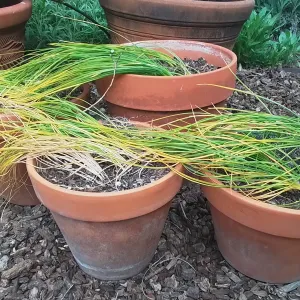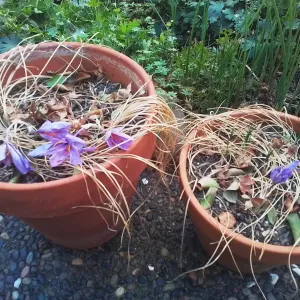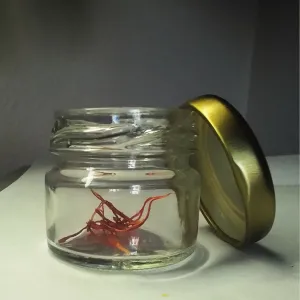Article and photos by Patricia Matteson
At Christmas 2023, my cousin Jenifer surprised me with a gift of 18 corms of saffron crocus, Crocus sativus L. (family Iridaceae). Her gift was loaded with emotional resonance. The recipe for bright yellow saffron cake, generously dotted with raisins and other dried fruit, is one of our Cornish family heirlooms.

On December 28, I planted the corms, following the one-page instructions that came with them as closely as possible: plant 4 inches apart and 4 inches deep in light, well-drained soil with a high nutrient content. I divided the bulbs among four terracotta pots filled with potting mix, only one of which was large enough to accommodate the recommended 4-inch planting depth. Most of the corms were planted 2 ½ - 3 inches deep. The pots stood outdoors in a sunny location where they’d be watered by rainfall. Seeing what happened over the following year was an intriguing process of discovery. I only fully understood my observations after starting to research saffron crocus for this article.

The instruction sheet says, “Saffron blooms in its first season, about 40 days after planting.” My corms quickly sprouted leaves, but didn’t bloom. Aware that the fall bulb planting season was long past, I wasn’t terribly surprised. The form of the plants was, however, an eye-opener. Each corm grew a long tuft of slender, limp leaves that lay horizontal by the time they reached their full 12-inch length.
Although I watered the pots after winter rains stopped, the saffron plants went dormant anyway, the leaves starting to dry up in April. This reminded me of freesias, which also become dormant in spring, surviving our hot summers without irrigation until the rains come again. Since both saffron and freesias are native to a Mediterranean climate with hot, dry summers like ours (the Mediterranean region itself and southern Africa, respectively), I decided to stop watering the now-unattractive saffron pots. I stowed them out of sight, in a place where they’d be open to eventual rainfall.
“Out of sight, out of mind.” In early November, I suddenly thought of the saffron pots, and at first couldn’t remember where I’d put them. Imagine my surprise when I found them and was greeted by purple flowers! Only five, but what a triumph! The saffron had indeed done fine without any watering; green leaves were poking out above every corm. I plucked the flowers and removed the three bright red stigmas from each flower with tweezers--that part of the flower is the saffron spice. After letting the stigmas dry at room temperature, I put them in a small bottle and admired my tiny, vivid harvest. (It takes stigmas from around 4,000 saffron crocus flowers to make one ounce of dry saffron.)

My experiment was actually, of course, no great triumph. I have since learned that I did almost everything wrong, from suboptimal growing conditions, through ill-timed flower harvesting, to dubious stigma drying. It was, however, proof of concept that saffron could be grown successfully in California largely or completely without irrigation. Indeed, I discovered that I was late to the game where California Master Gardeners are concerned: see “Plant Saffron!” From UCCE Sacramento... - UC Agriculture & Natural Resources | Facebook.
The eminent promoter of saffron as a potential high-value American specialty crop is the University of Vermont. Its North American Center for Saffron Research and Development, www.uvm.edu/~saffron/, offers detailed guidelines for growing and processing saffron. A good place to start is its brochure “Saffron: A Golden Opportunity for Diversified Farmers,” https://www.uvm.edu/~saffron/pages/factsheets/SaffrongeneralbrochureAug2021new.pdf, which illustrates the saffron plant’s production cycle better than my hit-or-miss observations do. It explains that saffron crocus flowers are sterile, and that the plant reproduces each year through the production of several new corms by each mother corm, which then withers. Commercial growers harvest new corms every few years for replanting.
Intrigued, I dug the saffron corms out of my four pots in early July this year, when the plants had become dormant after two seasons of growth (new corms are produced during the winter, while the leaves are green). Each of my original corms had been replaced by a clump of progeny, held together by a fibrous envelope. The young corms in each clump were a mix of sizes, from ¼ - 1 ¼ inch in diameter. The mother corm was reduced to a hard, dark, flattened disc stuck to the base of the clump. I harvested a total of 130 new corms!
Guess what Cousin Jenifer got as a Fourth of July present from me this year? Unlike me, she has a large, sunny area that she would like to turn into a saffron bed. So my precious corms will hopefully thrive—under better conditions than I gave them—to color and flavor her delicious saffron cakes, which our family enjoys at the end of every Christmas dinner.






